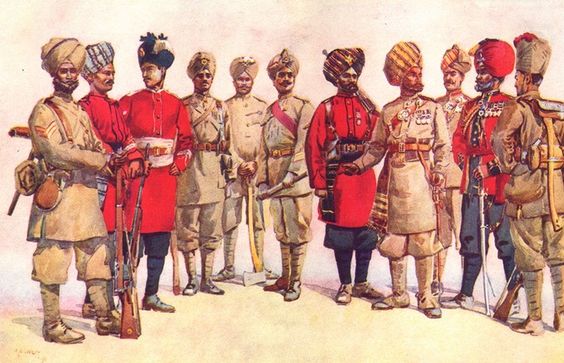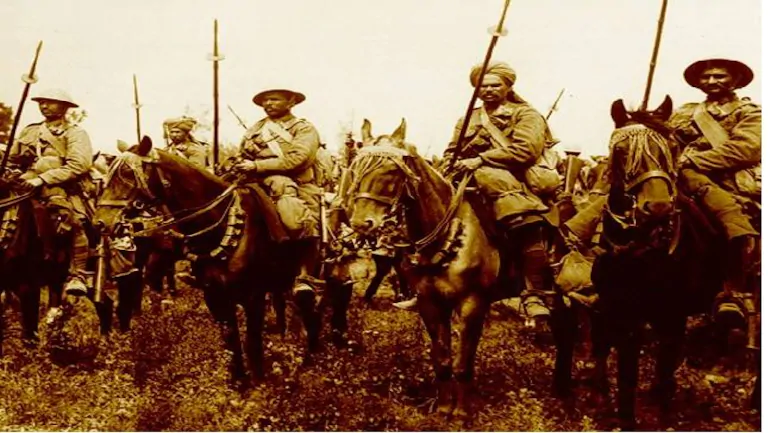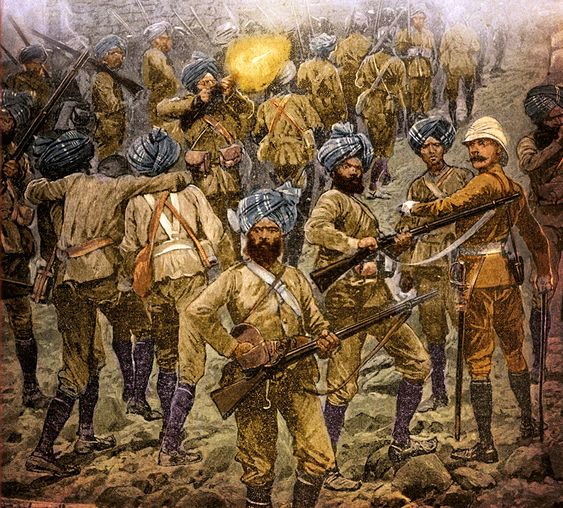
This essay will seek to show the trends of organization, regionalized recruitment policy, and institutional unification of the British Indian Army and how these trends were reproduced by the Pakistan Army after 1947.
Syed Hussain Shaheed Soherwordi
School of History & Classics, University of Edinburgh
Post-1857 Regional Recruitment Shifts – The Evolution of Punjabisation
The 1857 Mutiny or the War of Independence was a major upheaval for the colonial masters. From the military’s point of view, the main responsible factor in the outbreak of the mutiny was the Bengali soldier. His ethnic majority in the Indian Army and his defiance resulted in a war between the Indian soldiers on the one hand and the British troops and their loyalists, such as Punjabis, on the other. Therefore, the British military policy needed a structural overhauling, a well-organized, and systematic and planned British Indian Army. But for the British, the recruitment strategy needed a major shift from the defiant Bengalis to the loyalist Punjabis. Hence, recruitment from 1857 onwards shifted to the North and North Western regions of India (Present–day Pakistan) at the expense of other regions, especially Bengal. As a result, during the first half of the twentieth century the army was dominated by the soldiers from the North and North West of India. Gurkhas from Nepal, the Punjabis and the Pathans were preferred. The number of Punjabis increased gradually. The main ‘martial races’ of the west Punjab recruited were the Tiwanas, Noons, Gakkhars, Janguas, Awans, Baluchis, Khattars, Khokhars, and Sials.
The British Army’s senior officers believed that certain classes and communities in India were warrior races – Martial Races. Such classes and communities were believed to prove better and braver soldiers and to be more suitable for army service. The Eden Commission reported in 1879 that the Punjab was the ‘home of the most martial races of India’ and that it was ‘the nursery’ of the best soldiers. Michael O’Dwyer, who was the governor of Punjab at the time of the fateful Jallianwala Bagh massacre, endorsed the praise and appreciation of the Punjabi soldier expressed by such authorities as Lords Roberts and Kitchener. He said that their argument “was … irrefutable … that if India could only afford a small army of seventy-five thousand British (now reduced to under 60,000) and one hundred and sixty thousand Indian troops for the protection of a subcontinent of over 300 millions of people, it would be unwise to take any but the best Indian material and this was to be found mainly in the Punjab”.
The martial race theory helped to bring about an end to the Peel Commission recommendation that ‘the (regional) armies must balance each other’. According to Field Marshal Frederick Sleigh Roberts, the so-called ‘balance’ was discarded in the 1880s.
The Mutiny brought about a search for a martial race which would not turn against the British once again. The crux of the matter of the ‘martial race theory’ was that some races were superior to others. All natives were not equal in soldierly qualities. Roberts boldly asserted that ‘no comparison can be made between the martial values of a regiment recruited amongst the Ghurkhas of Nepal or the warlike races of Northern India (Punjab and NWFP), and those recruited from the effeminate peoples of the South’. The Punjab’s population accounted for less than 10% of British India, but contributed over half the entire Indian army. The British accommodated communities like Punjabis and Pakhtoons in the Army more than others. It was the beginning of establishing the trend whereby the future security and strategy of the subcontinent would be concentrated in the Punjab and not in Delhi, the capital of the subcontinent.
The reasons for the British tilt towards Punjabis were further substantiated by the perceived Russian threat to the British Empire. The second half of the nineteenth century witnessed a security and strategic peril from the North West – the Russian threat to North-Western India. The Russian Empire expanded in Central Asia, and, by 1850, it was about a thousand miles from the British Indian Empire.
Rather soon, it had to touch the tribal belt of NWFP, thus making Afghanistan a buffer between the two empires. Keeping Russians out of Afghanistan, or extending British influence over it, became a principle of British foreign policy. The policy became more assertive after Lord Lytton arrived in India as viceroy in April 1876. ‘The British had already fought two wars with Afghanistan and expected a third in which there might also possibly be Russian involvement’. According to Field Marshal Roberts, the presence of a ‘European army near our frontiers’ had ‘completely changed’ the position. Thus more focus was given to filling the deficiencies in the Indian Army by concentrating on recruitment from the areas closer to these borders, namely the Punjab.
 If the British needed the Punjabis’ loyalty in the post-Mutiny period, the Punjabis, for the solution of their personal financial problems, also needed the British.
If the British needed the Punjabis’ loyalty in the post-Mutiny period, the Punjabis, for the solution of their personal financial problems, also needed the British.
The personal economy of the peasantry contributed greatly to military recruitment from the Punjab. The availability of man-power, but no jobs, was an imbalanced equation in the region’s economy. It was an agrarian land, but due to shortage of water, soil fertility, erratic rainfall, and shortage of personal finances, the common peasant was facing acute poverty. The memories of the famines of 1753, 1759 and 1783 were still haunting the people. In the meantime, the struggle between Sikhs, Afghans and Mahrattas in the Punjab had further aggravated the situation. The desolation which Ahmed Shah’s army carried out on its route was expressed by the saying that was still current throughout Punjab: ‘What one eats and drinks is one’s own; the rest is Ahmed Shah’s’.
During the ‘great famine’ of 1783, the country was depopulated, the peasants abandoned their villages and died of disease and want in thousands; the state of anarchy was almost inconceivable. So many died of starvation that ‘bodies were thrown into wells unburied, mothers cast their children into rivers, and even cannibalism is said to have been restored’. In the circumstances, army service was a blessing in disguise. It provided them with an alternative to agricultural income. These peasants-turned-soldiers who until now were malnourished, under-paid and maltreated by the rich feudal class were more committed, hardworking, disciplined, and willing to take assignments with more rigor and vigour. The army provided everything: salary, uniform and prestige, as they were working directly with the colonial masters. A large number of them came from the salt range and the Potwar (Potohar) regions of Northern Punjab (especially the districts of Jehlum, Rawalpindi, and Attock) and the adjoining region of NWFP where the peasants were also facing serious economic problems. Indeed, military service provided a guaranteed salary while the peasant class working in the fields was faced with poverty and an uncertain source of income. The new recruitment policy aimed at exploiting the socio-economic life of the Punjab. As a result, the Raj concentrated more on the rural population and discouraged the urban and town-city dwellers. Recruitment focus on rural population was another lesson learnt from the 1857 Uprising.
The Punjab was the first province where an Act restricting land transfers was introduced. It was called the ‘Punjab Alienation of Land Act’. Its aim was to prevent the money-lender from exploiting the cultivator. To gain the support of the peasantry, several other legislative measures were also passed.
The cultivator in the Punjab was undergoing great hardships owing to the exploitation of the money-lender. It was true, therefore, that the peasant should get some relief. The Act limited the transfer of landed property only among the agricultural classes. Moreover, now the peasant could not be evicted by a civil court without the intervention of the revenue authorities. The Act had a three-pronged effect: it restored confidence in the British and encouraged peasants to join their ranks; the non-agricultural class was forced to join the armed forces to save their prestige, while even the landowning class sent their sons to join the British Army. If they already enjoyed a high eminence in the society, military service ranted them a more certain way of keeping their social status.
Granting rewards in return for loyalty was a very traditional and old tool of British domestic and international policy. This contrivance was applied in the North.
 Those who joined the British Indian Army were previously peasants. For them the best and the biggest reward was the allotment of land. The British used to allocate land to the soldiers in return for loyalty, gallantry, and on their retirement. Such land awards made the army service an attractive profession amongst the peasant-soldiers. It improved their socio-economic status. The policy of granting agrarian land as a reward for military service also encouraged recruitment. The British Indian government began construction of a new work of canals, their branches and distributaries in the plains of the Western Punjab. This process was initiated in 1885 and continued intermittently until the end of the British rule, during which period large tracts inhabited by semi-nomadic peoples were brought under cultivation. There were nine such areas, called the Canal Colonies, where land with sufficient canal water became available. The British Indian government distributed this land mainly on political considerations, that is, to reward people and communities for services to the Raj.
Those who joined the British Indian Army were previously peasants. For them the best and the biggest reward was the allotment of land. The British used to allocate land to the soldiers in return for loyalty, gallantry, and on their retirement. Such land awards made the army service an attractive profession amongst the peasant-soldiers. It improved their socio-economic status. The policy of granting agrarian land as a reward for military service also encouraged recruitment. The British Indian government began construction of a new work of canals, their branches and distributaries in the plains of the Western Punjab. This process was initiated in 1885 and continued intermittently until the end of the British rule, during which period large tracts inhabited by semi-nomadic peoples were brought under cultivation. There were nine such areas, called the Canal Colonies, where land with sufficient canal water became available. The British Indian government distributed this land mainly on political considerations, that is, to reward people and communities for services to the Raj.
Substantial tracts of the colony lands were allotted to ex-servicemen, both officers and other ranks, which enhanced the attraction of army service for peasants. Land was also granted for keeping breeding horses, camels, and other animals for the supply to the army and taking care of them. Substantial allotments of land were made to the veterans of World War I.54 No other field of work was pledging such a great return in the North than joining the Army. (Continues)
__________________
Courtesy: Centre for South Asian Studies, School of Social & Political Science, University of Edinburgh, Scotland, UK.
Click here for Part-I